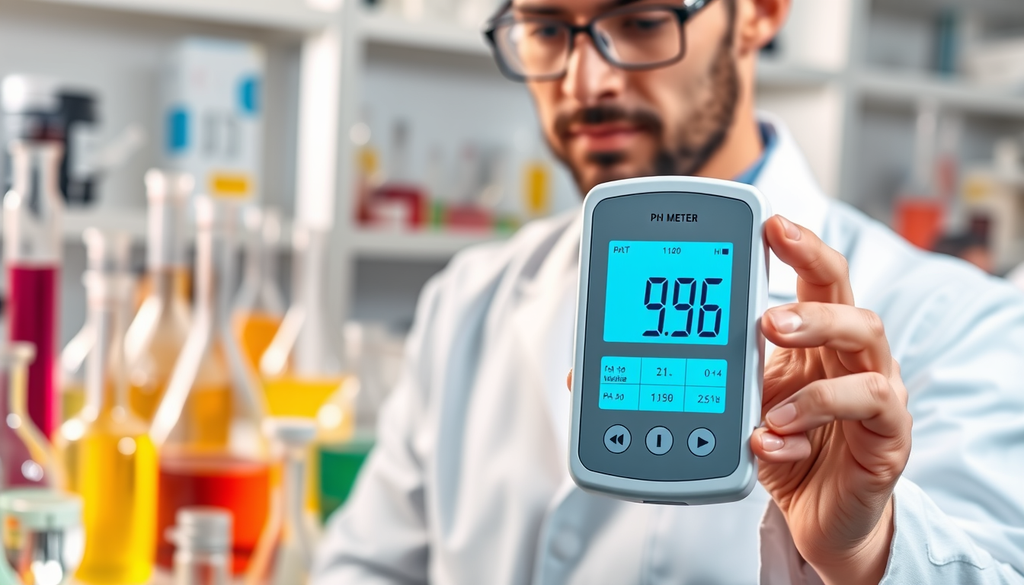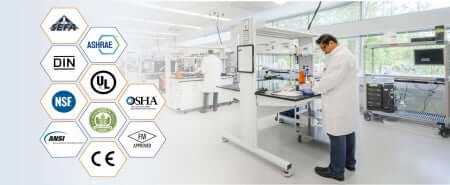Mastering Laboratory pH Measurement: A Comprehensive Guide to Using a pH Meter

Accurate pH measurement is a critical aspect of many scientific and industrial applications, from water treatment and environmental monitoring to pharmaceutical development and food production. At the heart of this essential analytical technique lies the humble pH meter - a versatile instrument that can unlock a wealth of insights when used properly. In this comprehensive guide, we'll explore the fundamentals of pH measurement, the key features and considerations when selecting a pH meter, and step-by-step instructions for effectively using this essential laboratory tool.
Understanding pH and Its Importance in the Lab
pH, or the potential of hydrogen, is a measure of the acidity or basicity of a solution. It is a logarithmic scale that ranges from 0 to 14, with 7 being the neutral point. Solutions with a pH less than 7 are considered acidic, while those with a pH greater than 7 are basic or alkaline.
Precise pH measurement is crucial in a wide range of laboratory applications, including:
Water Quality and Environmental Monitoring
Monitoring the pH of water sources, such as rivers, lakes, and groundwater, is essential for assessing water quality and ensuring compliance with environmental regulations.
Chemical and Pharmaceutical Research
Maintaining the correct pH is critical in chemical synthesis, drug development, and formulation processes to ensure product stability, efficacy, and safety.
Food and Beverage Production
pH plays a vital role in the production and quality control of food and beverages, from ensuring the proper fermentation of wine and beer to monitoring the acidity of juices and dairy products.
Biological and Biochemical Analyses
Many biological processes, such as enzyme activity and cellular function, are highly dependent on pH, making accurate pH measurement essential in fields like microbiology, cell culture, and biochemistry.
Selecting the Right pH Meter for Your Lab
When it comes to choosing a pH meter, there are several key factors to consider to ensure you select the best instrument for your specific needs:
Meter Type
pH meters can be classified into two main categories: benchtop and portable. Benchtop models are typically more accurate and feature-rich, making them ideal for laboratory settings, while portable pH meters offer the convenience of on-the-go measurements.
Electrode Type
The pH electrode is the heart of the pH measurement system. Depending on your application, you may need to choose between a standard glass electrode, a combination electrode (which includes a reference electrode), or a specialized electrode designed for specific sample types, such as food or soil.
Accuracy and Resolution
The accuracy and resolution of a pH meter are crucial, especially for applications that require precise measurements. Look for instruments with high-quality components and the ability to measure pH to multiple decimal places.
Additional Features
Many modern pH meters offer advanced features, such as automatic temperature compensation, data logging, and wireless connectivity, which can enhance the efficiency and accuracy of your pH measurements.
Using a pH Meter: Step-by-Step Instructions
Now that you understand the importance of pH measurement and the key considerations when selecting a pH meter, let's dive into the step-by-step process of using this essential laboratory instrument:
Preparation
- Ensure the pH meter is properly calibrated using standard buffer solutions.
- Clean the pH electrode and rinse it with deionized water.
- Allow the electrode to equilibrate to the temperature of the sample.
Measurement
- Immerse the pH electrode into the sample, making sure it is fully submerged.
- Wait for the reading to stabilize, typically 30 seconds to a minute.
- Record the pH value displayed on the meter.
Calibration and Maintenance
- Regularly calibrate the pH meter using standard buffer solutions to ensure accurate readings.
- Clean the pH electrode after each use and store it properly to maintain its performance.
- Replace the pH electrode when it becomes unresponsive or exhibits signs of deterioration.
Advanced Techniques
- Perform multiple measurements and calculate the average for increased precision.
- Use temperature compensation to account for changes in sample temperature.
- Employ data logging or wireless connectivity to streamline data collection and analysis.
By following these best practices, you can ensure accurate and reliable pH measurements in your laboratory, unlocking valuable insights and supporting the success of your scientific endeavors.
Troubleshooting Common pH Meter Issues
Even with proper care and maintenance, you may occasionally encounter challenges when using a pH meter. Here are some common issues and their potential solutions:
Slow or Unstable Readings
- Check the pH electrode for any dirt, grease, or air bubbles, and clean it accordingly
- Ensure the sample is well-mixed and at the appropriate temperature.
- Consider replacing the pH electrode if it is old or damaged.
Inaccurate Readings
- Verify the pH meter is properly calibrated using fresh buffer solutions.
- Check the electrode's condition and replace it if necessary.
- Ensure the sample is properly prepared and free from interfering substances.
Electrode Drift or Failure
- Replace the pH electrode if it is old or has been used extensively.
- Check the electrode's reference junction for any blockages or contamination.
- Ensure the electrode is stored correctly when not in use.
By understanding and addressing these common issues, you can maintain the reliability and performance of your pH meter, ensuring accurate and consistent measurements in your laboratory.
Conclusion
The pH meter is a versatile and essential tool in the modern laboratory, enabling precise measurements that are crucial for a wide range of scientific and industrial applications. By understanding the fundamentals of pH, selecting the right pH meter for your needs, and following best practices for its use and maintenance, you can unlock the full potential of this powerful instrument and contribute to the success of your research or operations.
Whether you're a seasoned scientist or a newcomer to the lab, mastering the art of pH measurement with a pH meter will equip you with the knowledge and skills to tackle complex analytical challenges with confidence. So, embrace the power of this essential laboratory tool and let it guide you on your journey of discovery and innovation.
Top Suppliers
Collections
- Dairy products
- Milk Testing Equipment
- physics lab
- Laboratory And Scientific Equi...
- microscopes
- ENT AND OPHTHALMIC
- measuring tools
- Centrifuge machine
- Micrometer
- Micropipette
- Silica Gel
- BOTANY PERMANENT MICRO-PREPARE...
- PERMANENT SLIDES
- centrifuge machine
- mask - type of mask
- medical products
- bod incubator
- Lab Chemical
- Do meter
- Lab Fabric items
- dental Autoclave
- medical mannequin
- White PVC Plastic Human Skelet...
- Human Body Part Models
- Heart Models
- Knee Joint Model
- Skull Models
- Laboratory Centrifuge
- Handi Centrifuges
- Microcentrifuge
- Table Top Centrifuge
- Digital Centrifuge Machine
- Pusher Centrifuge
- Laboratory Consumables
- Melting Point Apparatus
- Soxhlet Extraction Apparatus
- Distilling Apparatus
- Chemistry Lab Apparatus
- Chromatography Apparatus
- Diffusion Cell Apparatus
- Flash Point Apparatus
- Science Laboratory Equipment
- Profile Projectors
- Engineering Laboratory Equipme...
- Types of Microscopes
- General Laboratory Equipment
- Heating & Cooling Products
- Hospital equipment
- Testing Equipment
- Clean Air Equipment
- Engineering & Institute labora...
- HEAT & MASS TRANSFER LAB
- REFRIGERATION & AIR CONDITIONI...
- I.C. ENGINE LAB
- FLUID MECHANICS AND MACHINERY ...
- STRENGTH OF MATERIALS LAB
- EDM LAB equipment
- MATERIAL SCIENCE LAB
- FMS LAB
- CAD LAB
- AUTOMOBILE LAB
- MEASUREMENT & METROLOGY LAB
- DYNAMICS OF MACHINES LAB
- CENTRAL WORKSHOP
- Aerospace Engineering lab Equi...
- Biological Sciences lab Equipm...
- Chemical Engineering Equipment
- Civil Engineering
- Mechanical Engineering
- School And College University ...
- Lab Glassware & Chemical Items
- Zoology Lab Equipment
- Microbiology laboratory equipm...
- Chemistry Lab Products
- Botany Lab Product
- Biological Lab Equipment
- Department Of Anatomy Lab Equi...
- College of Nursing Lab Equipme...
- Endocrinology, Metabolism & Di...
- Haematology Lab Equipment
- Orthopaedics lab equipment
- Pediatric lab equipment
- Pathology lab equipment
- Physiology lab equipment
- Rheumatology lab equipment
- Urology lab equipment
- Obstetrics and Gynaecology lab...
- Otorhinolaryngology lab equipm...
- Pharmacology lab equipment
- Anatomy lab equipment
- Research Section lab equipment
- Pharmaceutical & Research Lab ...
- Physical Pharmacy Lab equipmen...
- Pharma Biology Laboratory Lab ...
- General Laboratory Equipment
- School And College University ...
- Medical College Lab equipment
- Biomedical Engineering Lab Equ...
- Biostatistics Lab Equipment
- Cardiology Lab Equipment
- College of Nursing Lab Equipme...
- Gastroenterology and Human Nut...
- Gastroenterology and Human Nut...
- Nursing Department lab equipme...
- Paediatrics lab equipment
- Reproductive Biology lab equip...
- Rheumatology lab equipment
- Biochemistry lab equipment
- Biophysics lab equipment
- Biotechnology lab equipment
- Centre for Community Medicine ...
- Nephrology lab equipment
- Pharmaceutical Chemistry Lab E...
- Microbiology & Pharmacology La...
- D Pharmacy equipment
- B pharmacy Equipments
- Pharmaceutics Laboratory Equip...
- Pharma Analysis Laboratory Equ...
- Animal House lab Equipment
- Pharmacognosy Laboratory Equip...
- Pharmacy laboratories equipmen...
- DEPARTMENT OF PHARMACOLOGY Equ...
- DEPARTMENT OF PHARMACOGNOSY Eq...
- DEPARTMENT OF P'CEUTICAL CHEMI...
- DEPARTMENT OF P'CEUTICS Equipm...
- PHARMACEUTICAL BIOTECHNOLOGY E...
- Livestock & Production Managem...
- Veterinary Sciences Lab Produc...
- Live Stock & Production Manage...
- Genetics and Plant Breeding la...
- Biotechnology lab equipment
- Seed Technology Lab Equipment
- Genetics and Plant Breeding la...
- Biotechnology
- Seed Technology
- Soil Science & Soil Water Cons...
- Entomology Lab equipment
- Agronomy Lab Equipment
- Metrological Lab Equipment
- Plant Pathology & Microbiology...
- Dental Equipment
- Microbiological Diagnostic Equ...
- Industrial & Soil Equipment
- Accessories
- Mega Offer
- Offer Zone
- Tiles Ceramic Laboratory Equip...
- analytical lab Equipment
- ayurvedic drug testing laborat...
- ayurvedic pharmacy instruments
- herbal testing laboratory
- mushroom lab Equipment
- lab plasticware
- agriculture Lab Equipment
- Agriculture College Lab Equipm...
- Labpro Banner 60%
- Labpro banner
- physics 60% Discount
- Hospital equipment supplier Ne...
Top Suppliers
Blog Posts
- green laser Light...
- Student Stereo Mi...
- Binocular Microsc...
- Laboratory Equipm...
- Prokaryos lab and...
- Pharmacy Lab
- Micro lab Laminar...
- MILK TESTING EQUI...
- Micrometer
- Centrifuge Machin...
- Chemistry Lab Equ...
- Agricultural coll...
- full body sanitiz...
- hydrometer for wi...
- Portable Bottle f...
- Egg Incubator
- Laboratorydeal of...
- A complete list o...
- different types o...
- Uses of Microscop...























